Oakleaf hydrangeas boast white pyramidal bloom clusters with color-changing capabilities. They emerge creamy white and age to dusky pink and green as summer progresses. By late fall, petals become light tan and papery, persisting on the stem into winter or yielding dark brown seeds for added interest.
Hydrangea quercifolia is a native shrub of the southeastern U.S. In addition to their floriferous clusters, the upright plants offer foliar texture and color. Large, deeply lobed leaves round out the growing season in rich autumnal hues like fiery red and burgundy purple. When the leaves drop, winter interest remains in copper-brown stems with exfoliating bark.
John Bartram, the American botanist and hybridizer, and his son William discovered the woody species while on a plant expedition in Georgia in the late 1700s. He named it after Quercus, the genus for oaks, in reference to the shape of the leaves (from the Latin folia).
Today’s cultivars possess improved forms and color variations among flowers and foliage. Blooms in light pink, deep rose, and wine red spice up the shade garden among the classically beautiful white. Birds, bees, and other pollinators visit for seeds and nectar-rich fertile florets. Whether fresh or dried, oakleaf flowers are beautiful cut flowers for long-lasting displays. Here are our favorite varieties!
Characteristics
The deciduous flowering shrubs are adaptable, durable, and beautiful landscape performers. They’re ideal in mixed borders, hedges, along woodland edges, and as single specimens. While colors change on the plant, soil pH doesn’t impact the bloom color as it does with bigleaf hydrangeas.
Pair the woody shrubs with other partial shade favorites for a woodland-inspired arrangement. Flowering dogwood, redbud, other hydrangeas, rhododendrons, camellias, roses, and boxwood make handsome specimen combinations. Perennials like hosta, phlox, coral bells, daylilies, astilbe, and hardy geraniums are graceful plant partners.
Oakleaf hydrangeas are hardy across USDA zones 5-9. They develop buds on old wood (the previous year’s growth). They set the buds soon after flowering to open the following spring.
If branches need pruning or shaping (they seldom do), trim them after blooms fade in the summer. Cutting too late in the season risks removing the new buds and lessening the next floral show. The exception is any winter-damaged canes; prune out damaged or weak canes in spring or anytime.
Since buds are set soon after flowering, they are susceptible to winter damage during extreme conditions. In lower zone 5, plants benefit from winter protection. Mulch or leaf litter provides insulation. If temperatures are consistently below 0°F (-18°C), consider a burlap wrap, frost cloth, or sheltered location to protect the stems, especially for young shrubs in their first or second growing seasons.
Growing Conditions
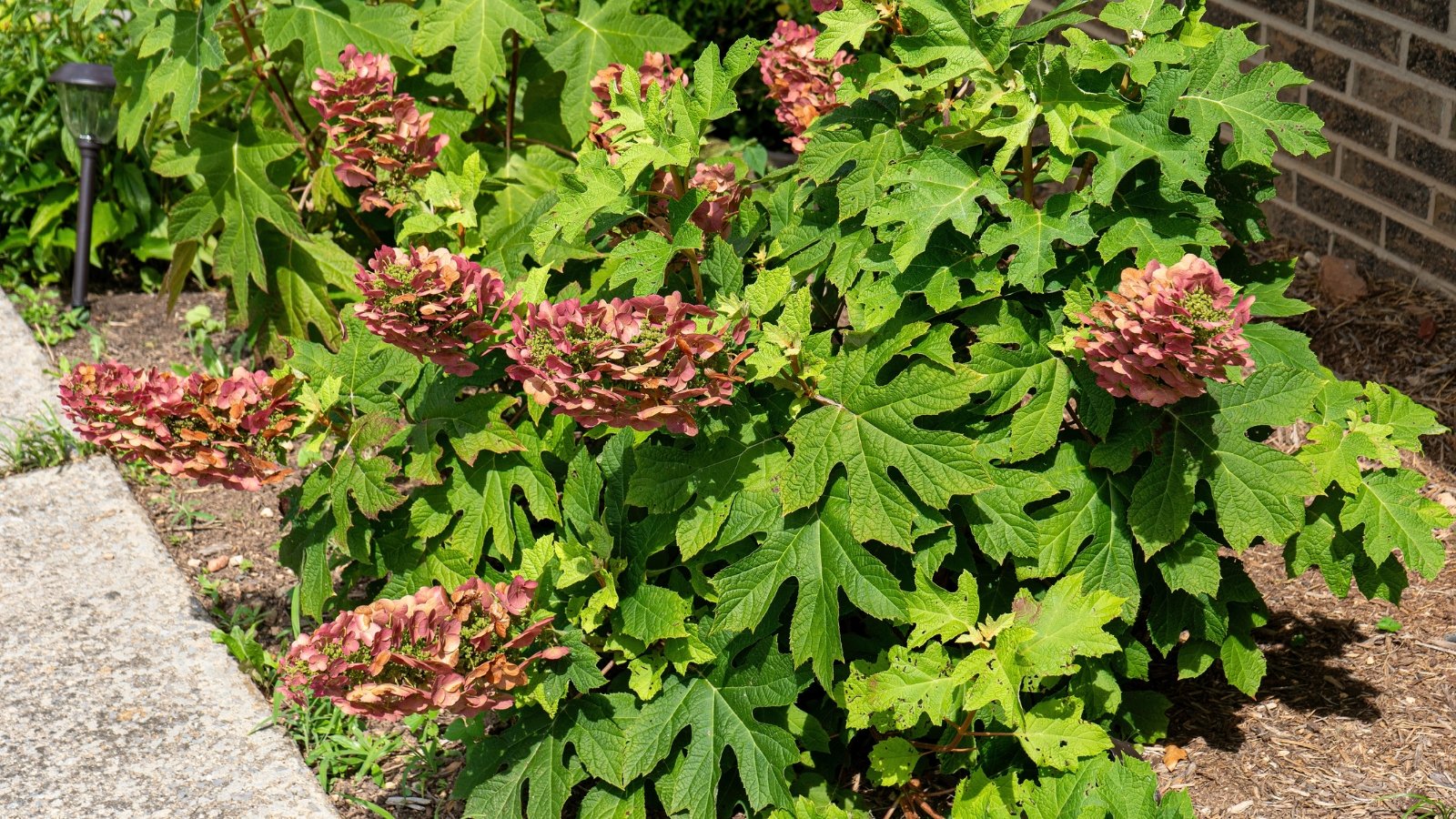
Oakleaf hydrangeas are carefree growers with a naturalized aesthetic. Native to the southeastern U.S., they tolerate hot and humid summer conditions.
They grow best in full sunlight and partial shade. Provide midday protection from direct afternoon sun, especially in hot regions. In cool climates, they’ll grow in more sun as long as soil moisture is adequate.
Oakleaf types thrive in moist, well-drained soils. Once established, they withstand varying conditions. A generous layer of mulch, compost, or leaves each spring aids in retaining moisture and regulating soil temperatures. If under tree cover, seasonal leaf drop provides natural protection.
‘Alice’
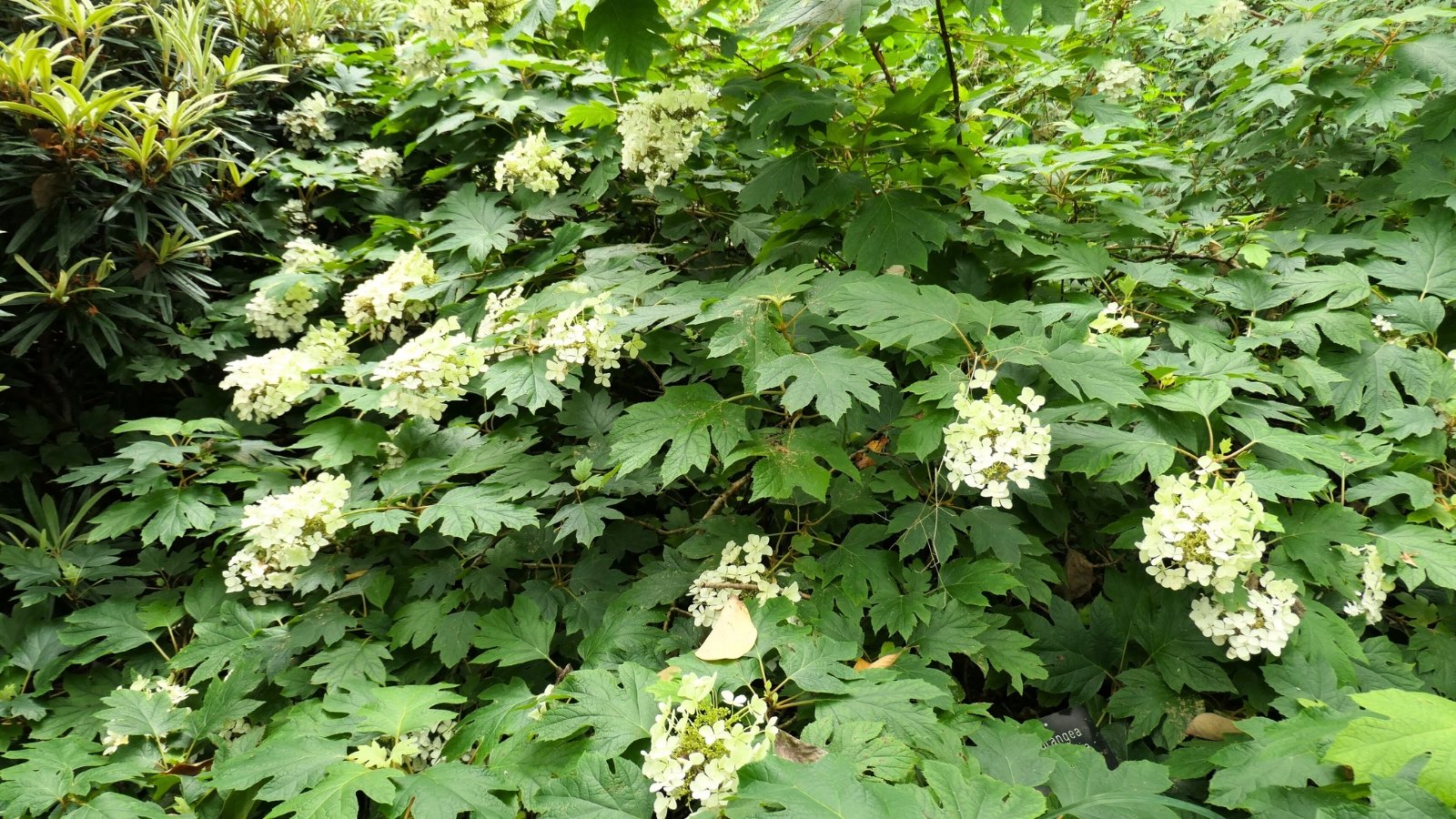
|
|
botanical name Hydrangea quercifolia ‘Alice’ |
|---|---|
|
|
height 5-8’ |
‘Alice’ is the grande dame of the group, growing as wide as she is tall. In optimal conditions, plants reach 12 feet!
Her large, arching panicles reach as long as 10 to 14 inches. Clusters of the characteristic white, four-petaled flowers emerge in June and July and last six to eight weeks.
‘Alice’ has upright branching and a broad, rounded form. Its deeply lobed, eight-inch leaves are a kaleidoscope of fall color. As temperatures cool, simultaneous purple, burgundy, bronze, and red tones appear.
Expert plantsman Dr. Michael Dirr introduced ‘Alice’ through his Georgia Plant Introductions program. The selection is a gold medal performer in the landscape, as the State Botanical Garden of Georgia acknowledged in 2000.
‘Snow Queen’
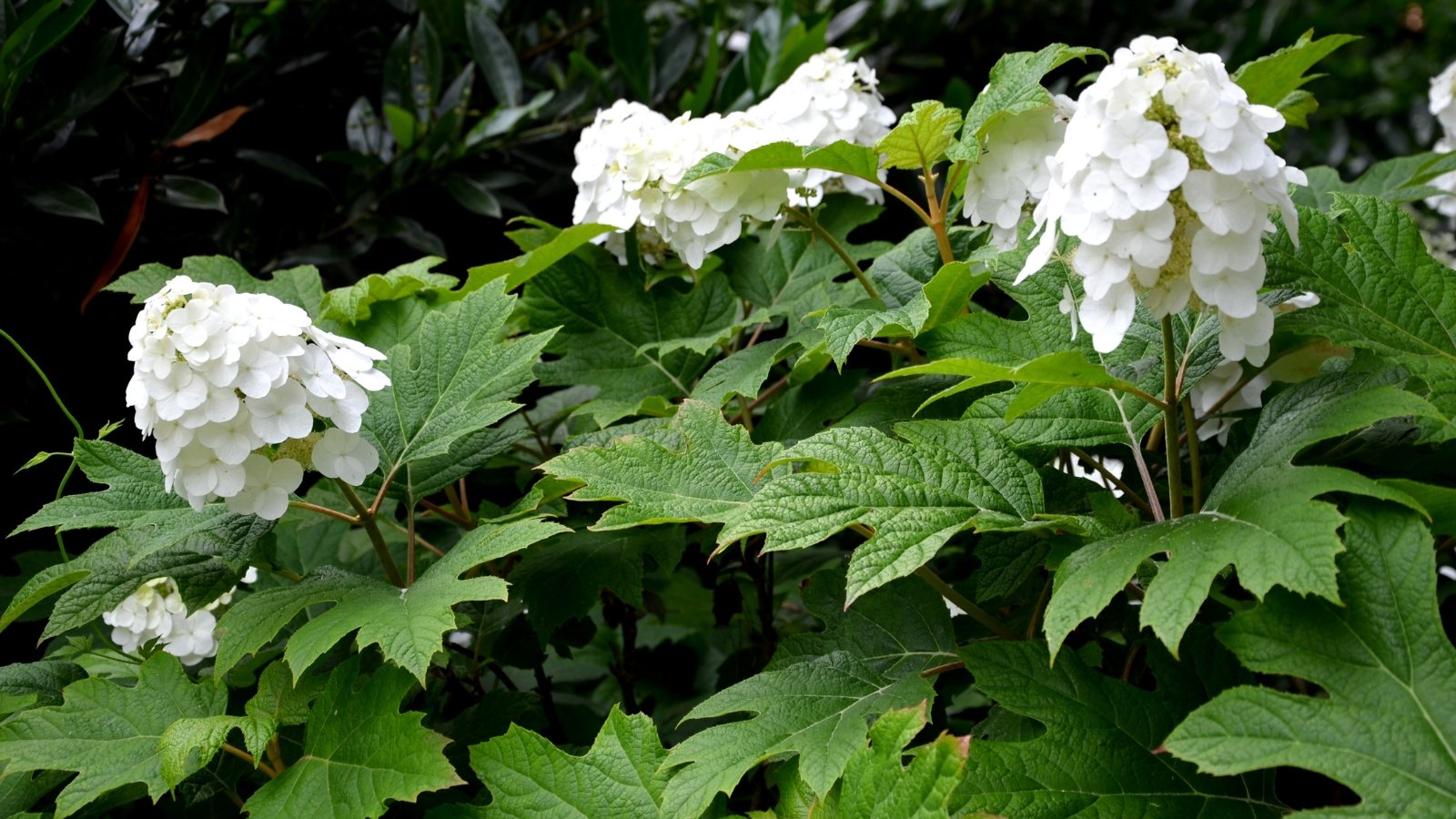
|
botanical name Hydrangea quercifolia ‘Flemygea’ | |
|
height 4-6’ |
‘Snow Queen’ is a stately specimen with long, pyramidal panicles of pure white flowers that take on rosy pink and purple tones as the season progresses. The dramatic bloom clusters reach one foot long among large, fresh-green leaves. The shapely foliage turns vibrant shades of orange, crimson, and wine red.
‘Snow Queen’ resembles the straight species but with a tidier, rounded, upright habit. It features more prominent blooms and sturdier stems to hold them aloft.
William Flemer of Princeton Nurseries in New Jersey selected ‘Snow Queen.’ It received the prestigious Award of Garden Merit from the Royal Horticulture Society for its flowers, compact habit, and performance.
‘Gatsby Moon’
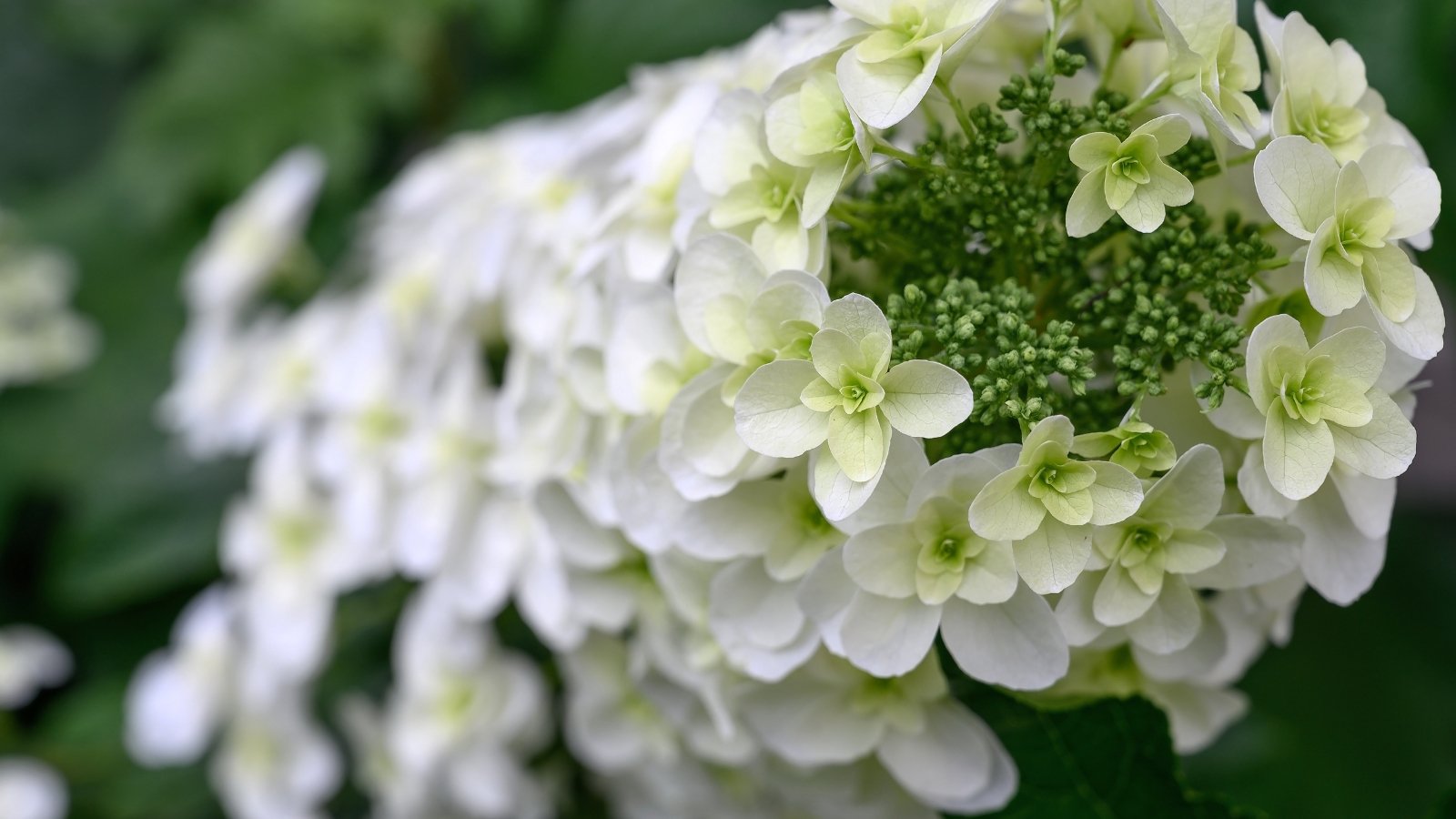
|
botanical name Hydrangea quercifolia ‘Brother Edward’ | |
|
height 6-8’ |
Look to ‘Gatsby Moon’ for enormous double blooms on large shrubs. The tightly packed cones contain hundreds of overlapping florets for a full, condensed, ruffled effect. The creamy white panicles contrast the true green foliage and coppery stems.
Instead of blooms aging to pink, ‘Gatsby Moon’ evolves to a pale, mossy green. In autumn, handsome leaves take on mahogany red shades.
The ‘Gatsby’ series of oakleaf hydrangeas boasts sturdy stems to support the hefty blooms through summer weather. The bloomers are part of the Proven WinnersⓇ “ColorChoice” selections for easy-care and highly ornamental shrubs.
‘Pee Wee’
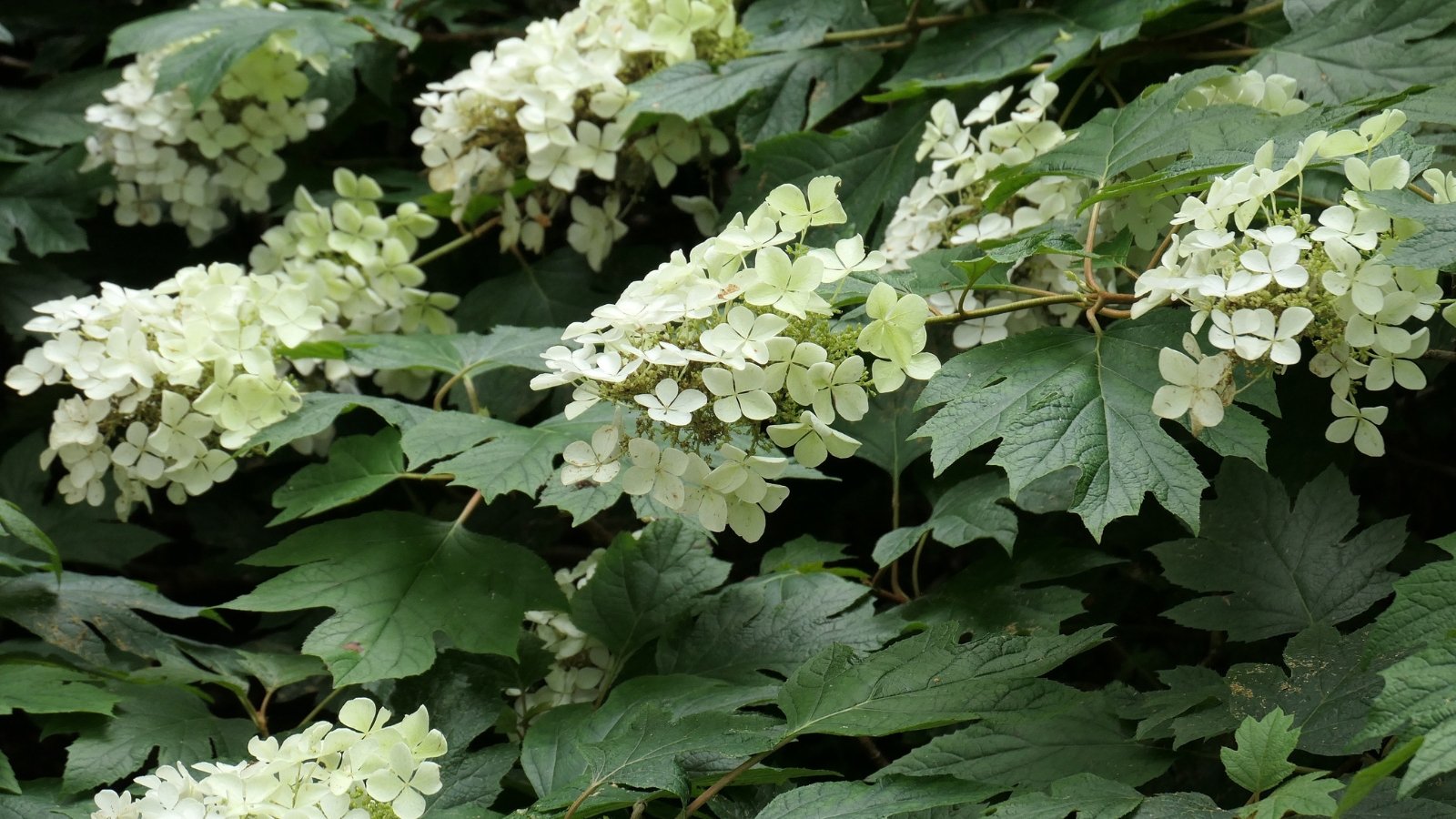
|
botanical name Hydrangea quercifolia ‘Pee Wee’ | |
|
height 3-4’ |
True to its name, ’Pee Wee’ has a compact stature and contained habit. It also has smaller leaves and inflorescences than many other varieties. While it’s not the smallest oakleaf hydrangea, it’s ideal for tucking into various garden spaces.
Although more diminutive, ‘Pee Wee’ bears the species’ ivory-white florets and autumnal color in yellows, oranges, purples, and reds. A slight point on each petal gives it a crisp, airy look. After the flowers fade to pink and tawny, brown seeds persist into winter.
‘Ruby Slippers’
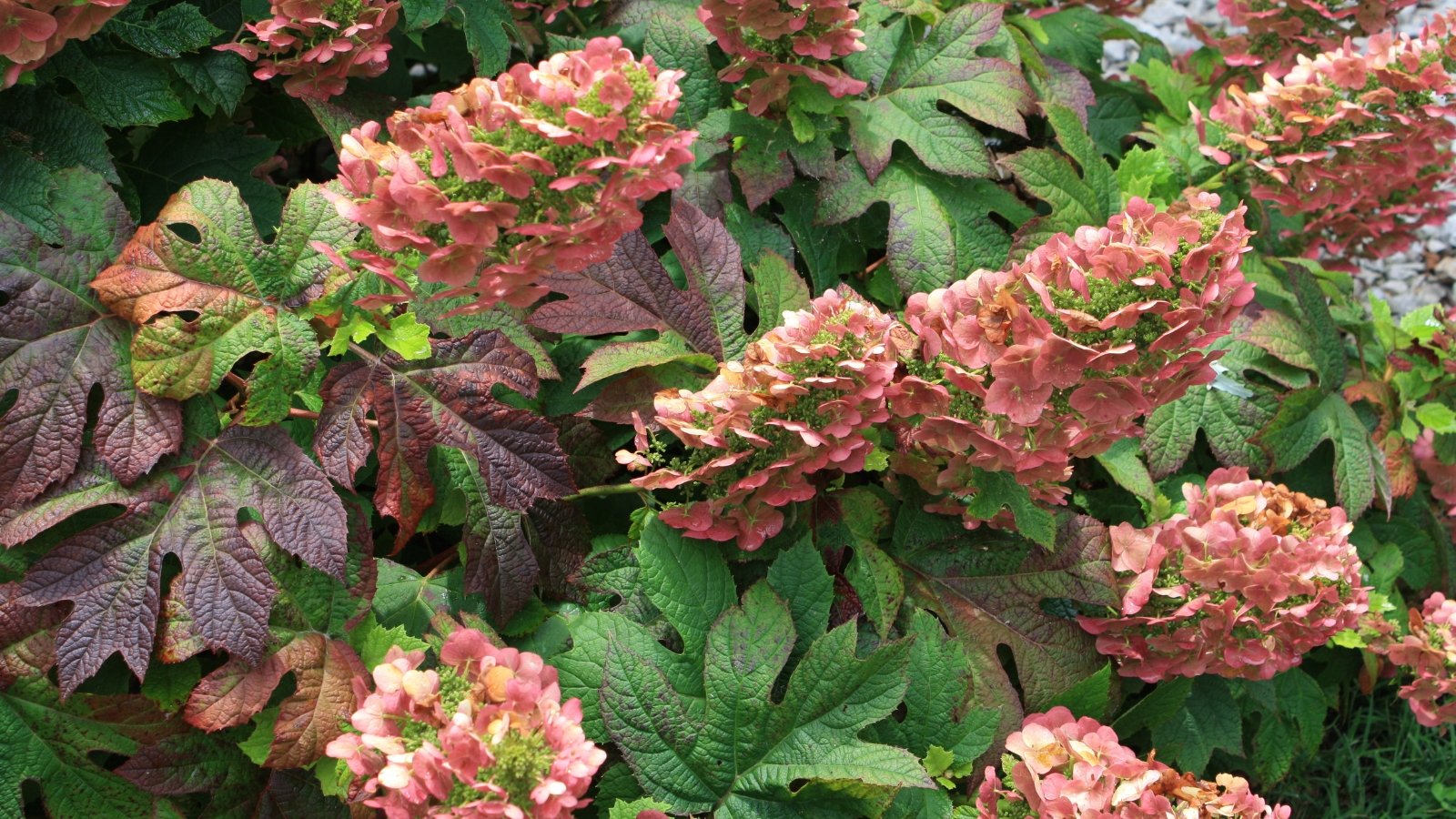
|
botanical name Hydrangea quercifolia ‘Ruby Slippers’ | |
|
height 3-4’ |
‘Ruby Slippers’ crosses ‘Snow Queen’ and ‘Pee Wee’ for a sparkling cultivar. Flowers emerge white and turn shades of rosy cerise and light pink. They age to ruby red and cover the shrubs in white sprays.
The woody bloomers are compact and hold their nearly ten-inch flower clusters upright. Stems in all directions point the clusters outward for an all-over display.
The U.S. National Arboretum in Washington, DC, introduced the innovative selection in 2010. ‘Ruby’s’ fall foliage has deep scarlet burnishes to match her “slippers.”
‘Snowflake’
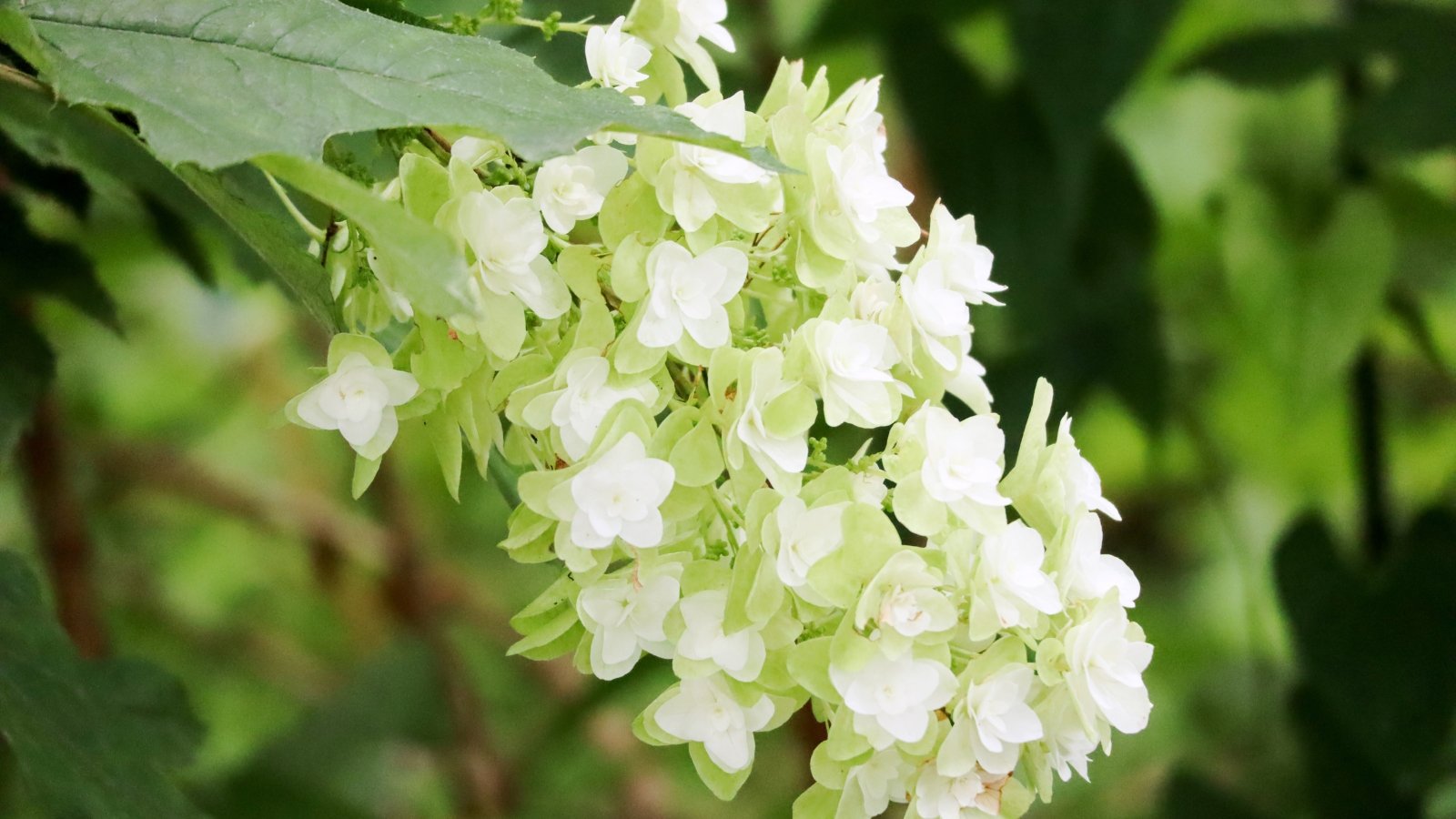
|
botanical name Hydrangea quercifolia ‘Brido’ | |
|
height 6-12’ |
‘Snowflake’ brings a little snow in summer with large bloom clusters filled with double flowers. Like ‘Snow Queen,’ the shrubs are tall and wide and grow as much as 12 feet in both directions.
Each floret of ‘Snowflake’ has a double layer of petals (actually sepals for all oakleaf hydrangeas). The sepals are larger on the base layer and more petite on the upper. As the flowers transition, the billowy arching blooms are a combination of white, dusky pink, and green sepals.
Aldridge Nursery in Alabama introduced the big bloomer in the 1970s. Eddie Aldridge and his father, Loren, selected the plant from a wild specimen in the woods.
‘Gatsby Pink’
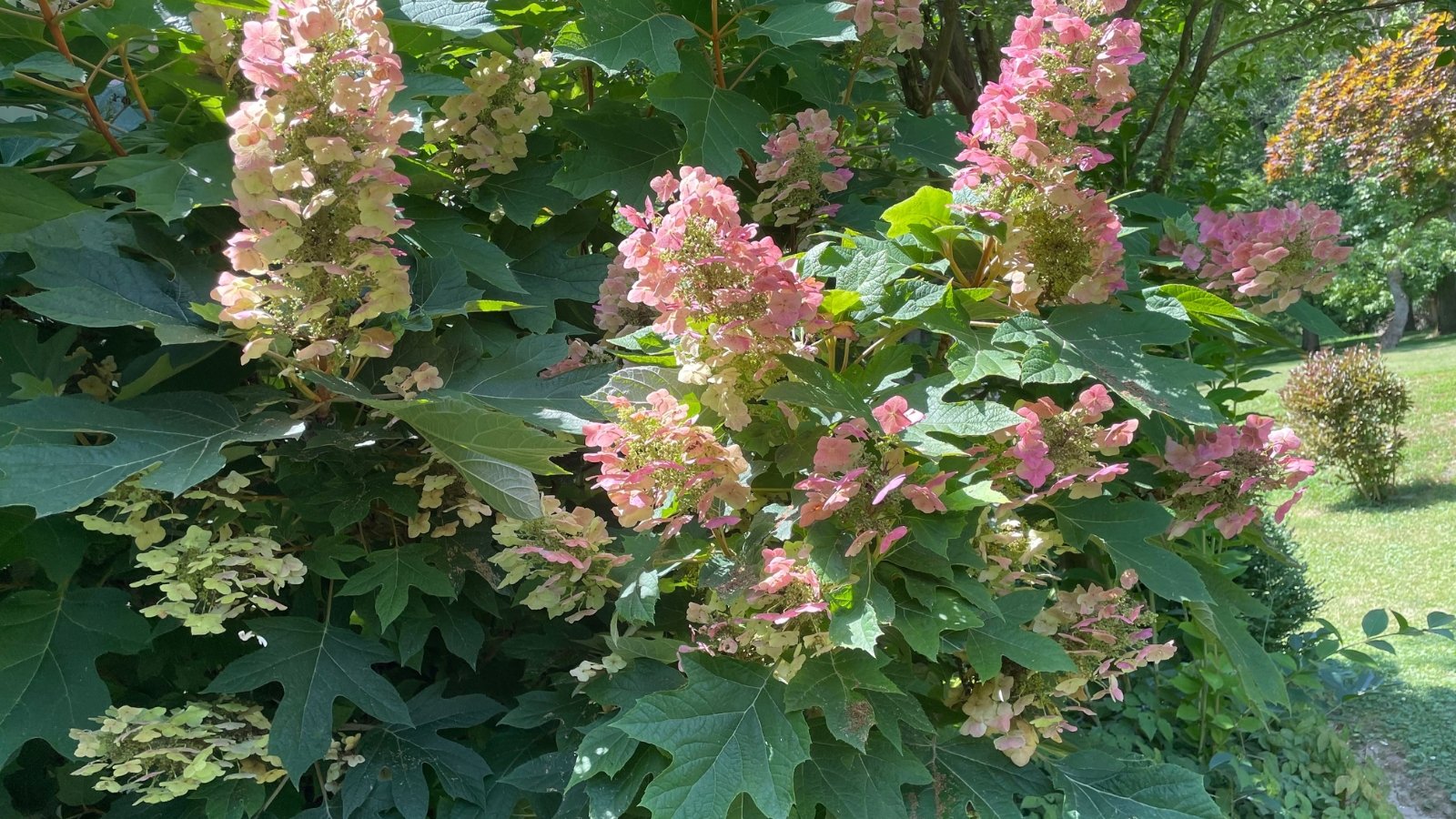
|
botanical name Hydrangea quercifolia ‘JoAnn’ | |
|
height 6-8’ |
‘Gatsby Pink’ is a spin on the white ‘Gatsby Moon.’ Flowers emerge in creamy white and change to pink, with deeper pink undersides. The blossoms nod within pyramidal panicles, revealing the deep rose shades among light pinks and whites.
‘Gatsby Pink’ blooms in early summer with color that lasts until frost. The color-changing continues when the foliage turns mahogany-purple in fall, ‘Gatsby Pink’ is shade-tolerant for blooms among heavier canopies.
‘Jetstream’
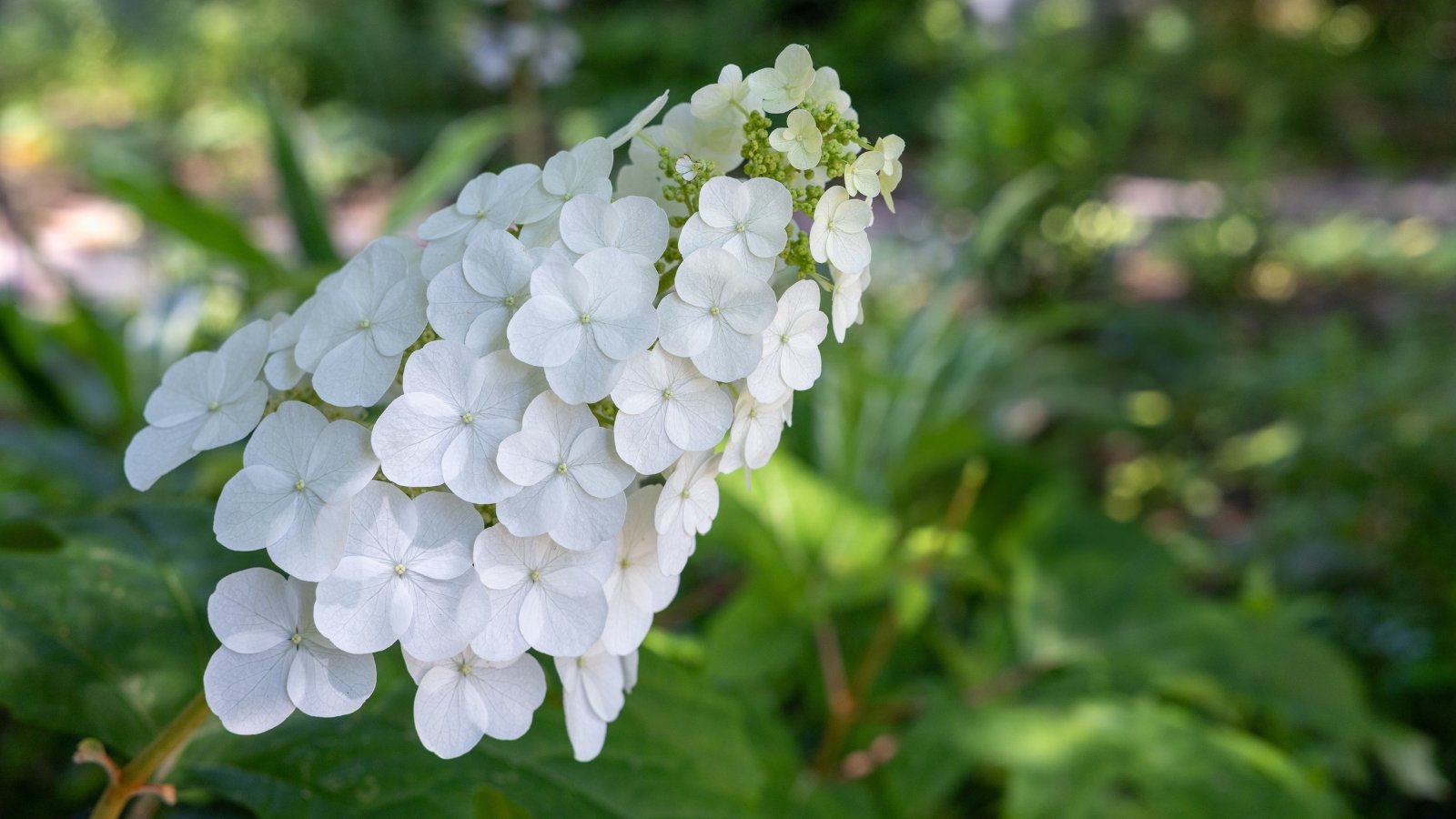
|
botanical name Hydrangea quercifolia ‘Piihq-i’ | |
|
height 5-6’ |
‘Jetstream’ offers a cloudburst of nearly 10-inch-long pyramidal cones on compact branches. Large sepals overlap and fan delicately among the clusters.
The dense shrubs boast sturdy stems that keep the weighty blooms from drooping and flopping. As temperatures cool and plants prepare for winter dormancy, foliage turns orange-red.
‘Jetstream’ is leaf-spot resistant, lessening the likelihood of unsightly fungal spots and potential plant stress. Branching stems create good floral coverage among the bushy growers, with flowers at multiple heights among the foliage.
‘Amethyst’
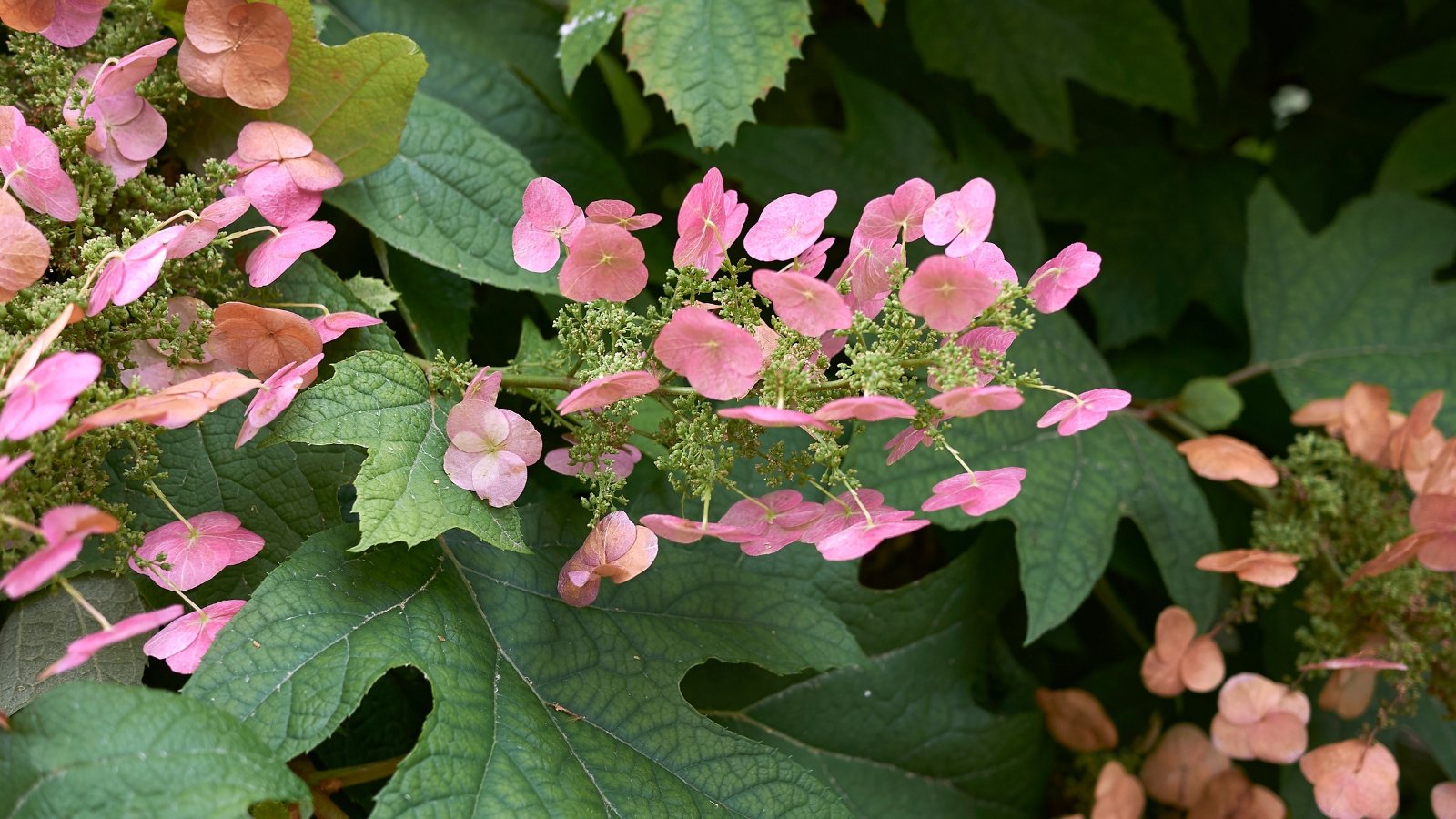
|
botanical name Hydrangea quercifolia ‘Amethyst’ | |
|
height 5-6’ |
‘Amethyst’ holds six-inch long inflorescences that quickly change from white to wine red. The coloration is a surprise in the woodland garden. Autumnal foliage in purple-red complements the long-lasting flower.
Reportedly, Dr. Michael Dirr discovered the selection while driving with his mother in Cincinnati, Ohio. Like ‘Ruby Slippers,’ its deep red florets are striking among the species. ‘Amethyst’ is slightly bigger. With its held color, ‘Amethyst’ is exceptional when cut or dried in floral arrangements.
‘Gatsby Gal’
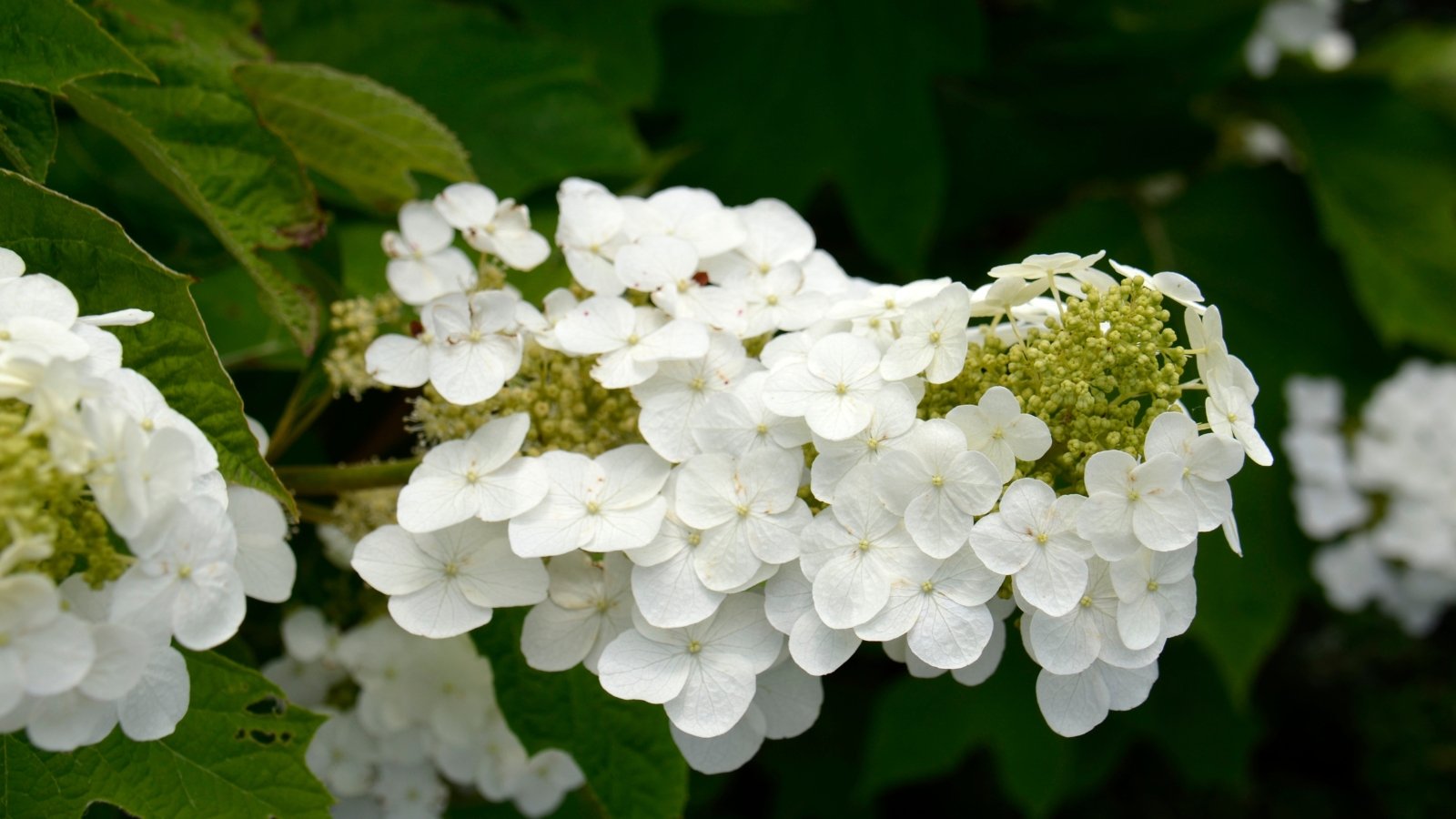
|
botanical name Hydrangea quercifolia ‘Brenhill’ | |
|
height 5-6’ |
Big, white blooms rise above the smaller habit of ‘Gatsby Gal.’ It grows slightly less tall and wide than others in the ‘Gatsby’ series. It’s a good fit for foundation plantings, hedges, woodland borders, and singular specimens.
Buds and fertile florets are light green for a soft contrast. The clean, florific display makes ‘Gatsby Gal’ a prize for spots that can afford a mid-size shrub. Stems hold the panicles in terminal clusters pointed in all directions for sprays of bright white from head to toe.
‘Little Honey’
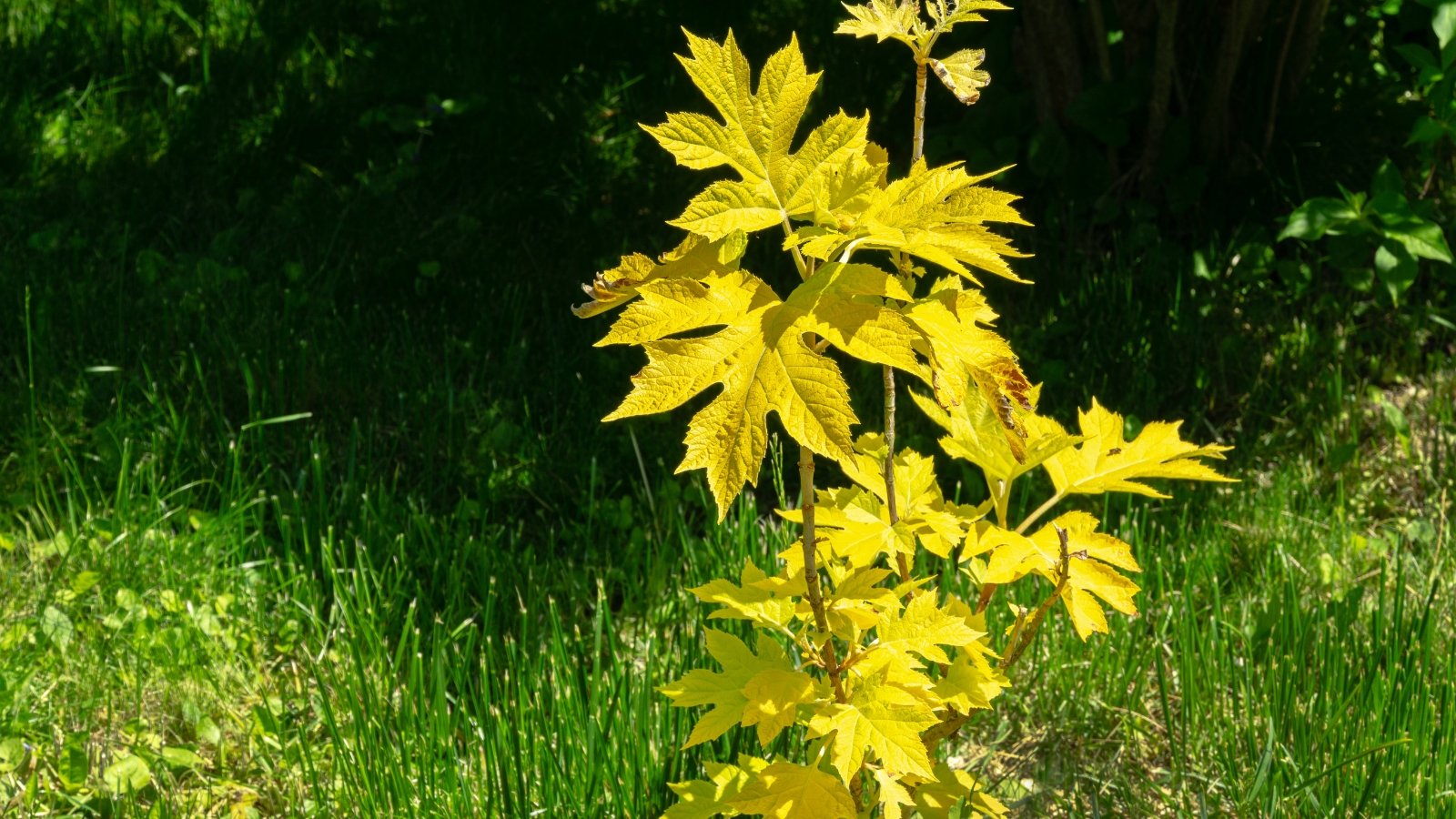
|
botanical name Hydrangea quercifolia ‘Little Honey’ | |
|
height 3-4’ |
‘Little Honey’ boasts three seasons of dynamic foliage. Deeply lobed four- to seven-inch leaves emerge golden yellow in the spring. Gold tones last through early summer, followed by a transition to chartreuse and green. The display continues with fiery crimson before frost.
‘Little Honey’ is a sport (genetic mutation) of ‘Pee Wee.’ That accounts for the dwarf form and five-inch flower cones. Blooming white, they evolve to antique pink as they age.
While the showy leaves are its best feature, a bonus of ‘Little Honey’ is sporadic repeat flowering until frost. Stems turn coppery red in winter.
‘Harmony’
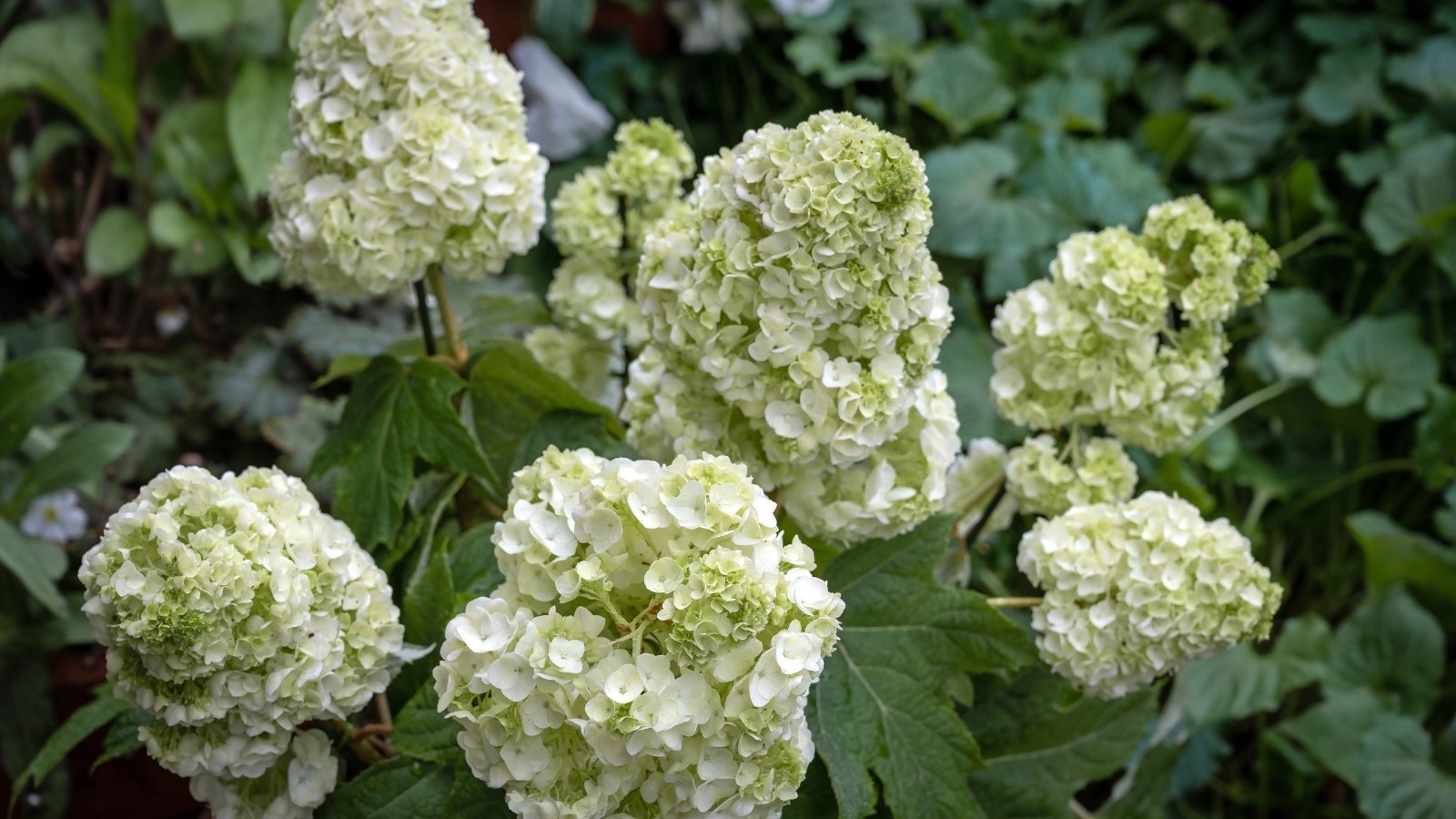
|
botanical name Hydrangea quercifolia ‘Harmony’ | |
|
height 6’ |
‘Harmony’ produces dense flower heads that reach one foot long. It’s similar to ‘Gatsby’ with its large, white panicles, but the stems of this selection aren’t as strong. It has a naturalistic, old-fashioned appeal.
With weak stems, flowers droop, hang, and cascade under their weight. This aspect improves as plants mature and stems thicken.
‘Harmony’ is another Aldridge introduction out of Alabama (one of oakleaf hydrangea’s preferred native growing areas). ‘Harmony’ was growing in a church cemetery near Rainbow City.
‘Munchkin’
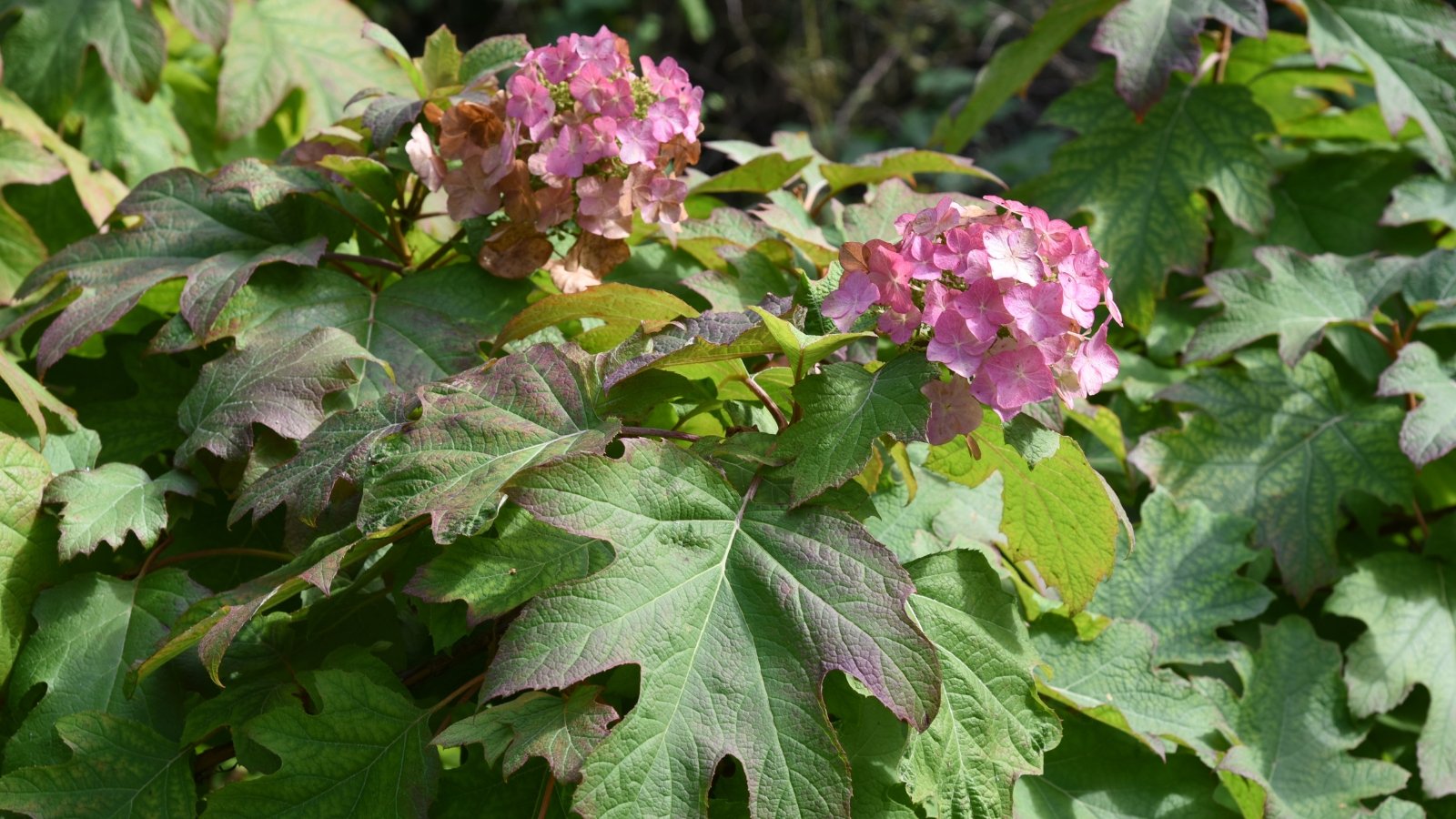
|
botanical name Hydrangea quercifolia ‘Munchkin’ | |
|
height 3-4.5’ |
Like ‘Ruby Slippers,’ ‘Munchkin’ is a 2010 introduction to the U.S. National Arboretum. It’s a selection from seedlings of an open-pollinated ‘Sike’s Dwarf’ oakleaf hydrangea.
‘Munchkin’ produces numerous six- to seven-inch inflorescences in white that age to showy pink. Bloom spikes stand tall on solid branches, even after a heavy summer storm. The leaves are rich, dark green, and take on brick red autumnal tones.
The parent ‘Sike’s Dwarf’ grows only two to three feet tall and three to four feet wide. Its mounding form is among the smallest of the group, and proportional leaves and flowers are also smaller. Three- to four-inch cones brighten deep green leaves that turn the signature bronze, burgundy, and purple in the cool season.
‘Queen of Hearts’
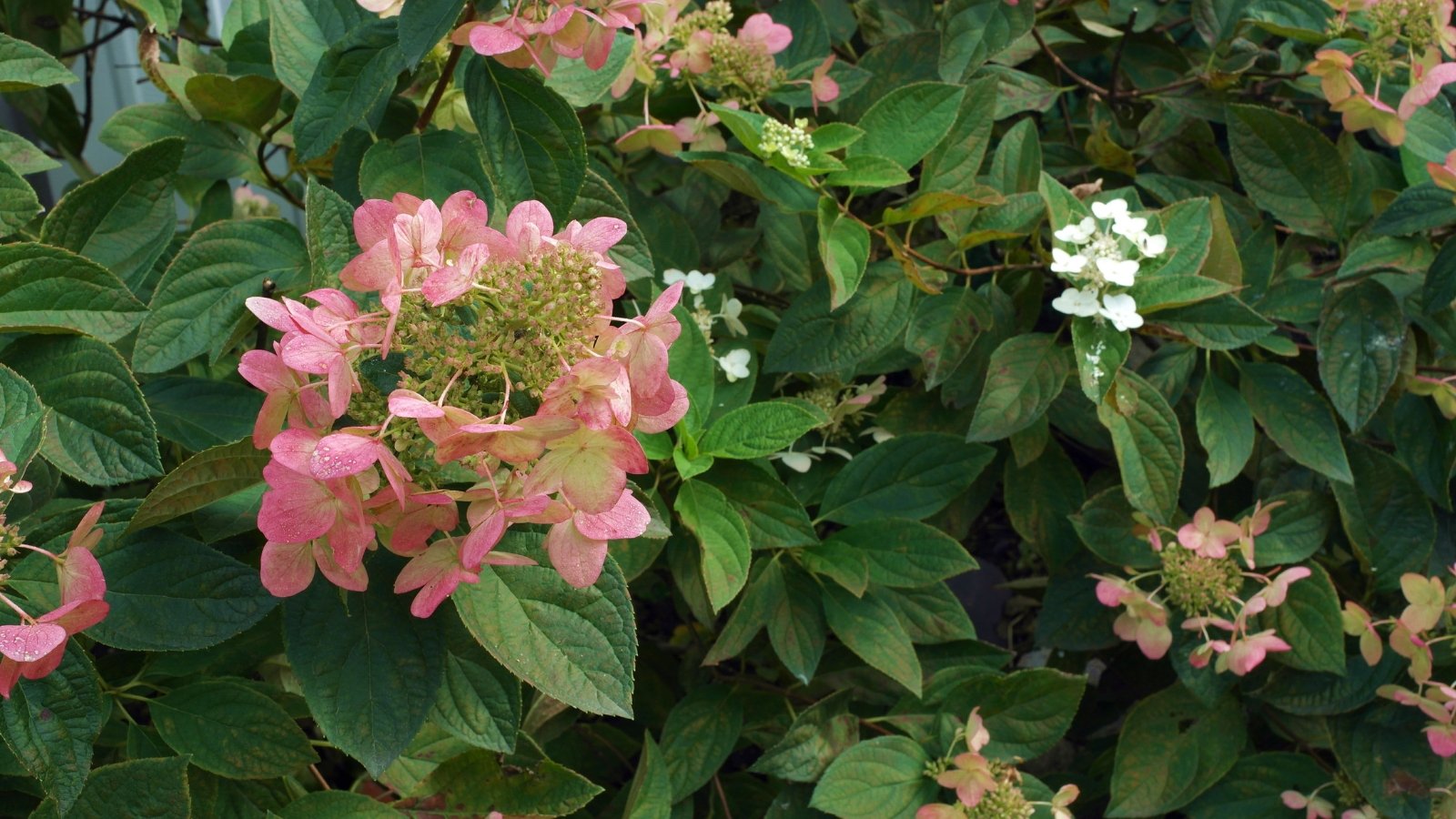
|
botanical name Hydrangea quercifolia ‘Queen of Hearts’ | |
|
height 6-7’ |
Out of the same seeding population as ‘Ruby Slippers’ is ‘Queen of Hearts,’ another hybrid of ‘Snow Queen’ and ‘Pee Wee.’ The National Arboretum’s shrub breeding program in McMinnville, Tennessee, selected ‘Queen’ for its rounded habit and large flower heads.
‘Queen of Hearts’ has nearly 10-inch long inflorescences and a heavy flush of flowers. The ivory-white petals mature to a vintage rose color.
Blooms appear a week to ten days later than other oakleaf varieties and remain attractive as others fade. The extended late-season interest is showy as other flowering plants become quiet in the late-summer display.
‘Gatsby Star’
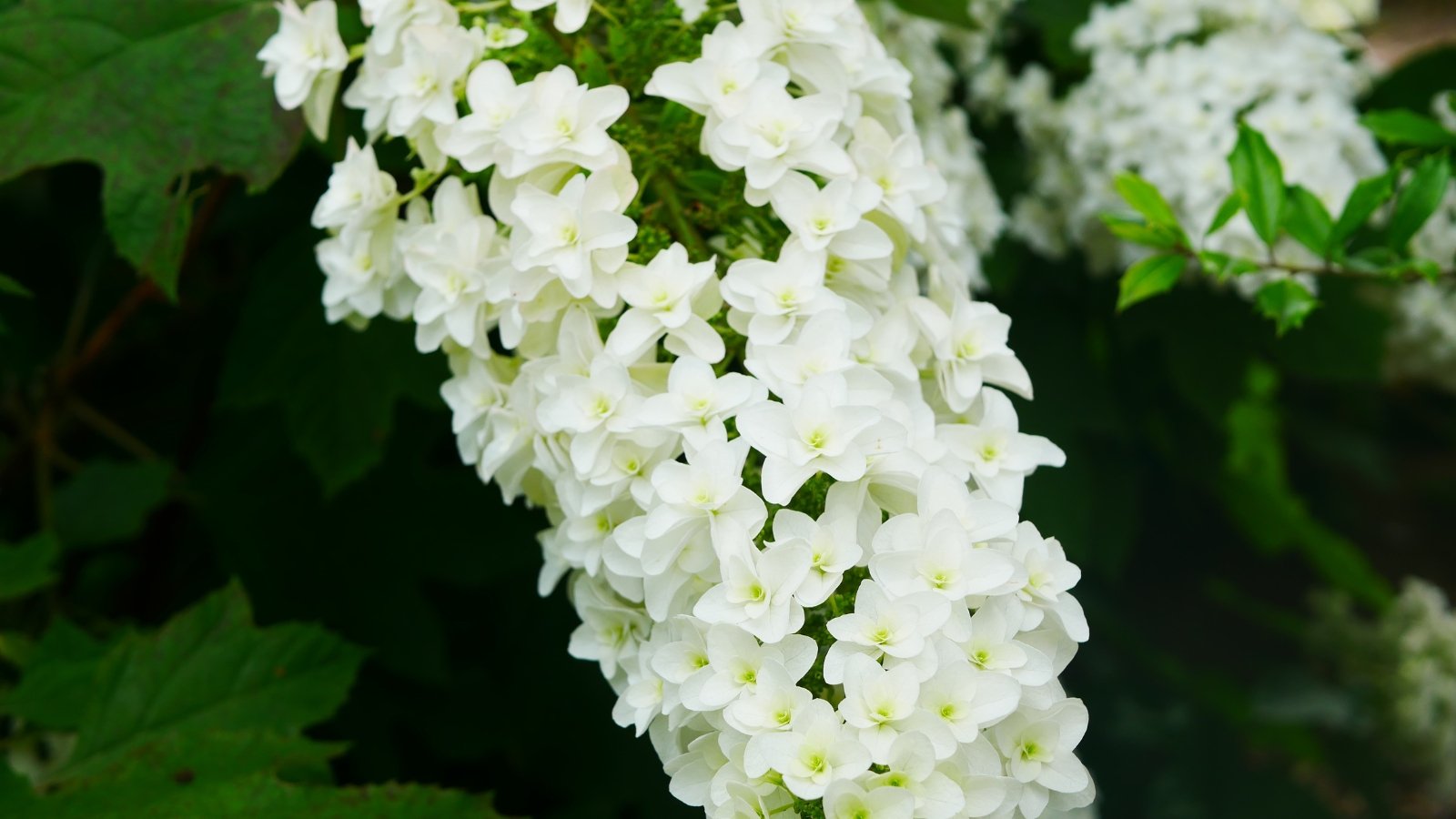
|
botanical name Hydrangea quercifolia ‘Doughill’ | |
|
height 6-8’ |
‘Gatsby Star’ resembles the layered sepals of ‘Snowflake’ except with star-shaped petals. The stacked, pointed petals give the flower head a lacy texture—delicate, intricate, and loaded with florets.
Bloom centers are light, creamy green. Each blossom holds up to four layers of sepals.
Like others in the series, ‘Gatsby Star’ has a well-rounded form, big blooms, and claret autumn foliage. Others, like ‘Gatsby Gal,’ replace it in the series for vigor, performance, and robust stems.




